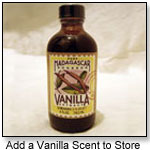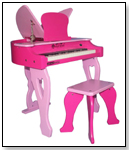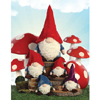|
|
How to Make Your Store Special Use All the Senses to Build a CommunityWhile sex appeal may seem out of place in a toy store, most paying customers and staff are adults and are at least subliminally aware of some sort of attraction. Why not use that to your advantage, suggested Steve Olson, CFO of the Persuasion Institute. Explore Touch "If you're not touching someone, you're not quite trusting completely." — Steve Olson, a sales and persuasion consultant.
"A woman staff member touching a man on the arm and flirting goes a long way" toward making the sale, said Olson. "Women buyers, however, are very reluctant to be touched by male salespeople. Women are more impressed by knowledge." Touching breaks down barriers, he continued. "Keep it on the lower arm or elbow. If it's a good conversation, it might go to the shoulder." Even age gaps can be closed by a light touch on the arm, Olson said. "It lowers the barriers. If you're not touching someone, you're not quite trusting completely." Give Them Space Conversely, customers need to feel safe before they're overwhelmed by friendly staff. “We wait for them to get past that 6’ dead zone at the entrance, then we come out from behind the counter and greet them with a ‘good morning’ or ‘good afternoon,’” noted Terry Myers, owner of Kaleidoscope Toys in Round Rock, Texas. Greet Them Warmly and Specifically When you tell an employee to stock a shelf, he or she might think that’s the most important, and only, task to focus on. Let your employees know that such tasks can and need to be stopped when a customer walks in. However, it's important that employees know what to say — and what phrases to avoid — to keep customers coming. Don’t tell your employees, “Just say hi!” Give guidance on what to say next. After asking how they can help, “if the customer still responds that he/she is ‘just looking,’ we ask if they have been in to see us before,” Ray Goodhart, president of Ages & Stages Toy Box in Golden, Colo., told TDmonthly. “Yes” customers are then introduced to new products, and “no” customers are taken on a tour of the store. “Never start with, ‘Can I help you?’ advised Joe Berardoni Sr., owner of Pun’s Toy Shop in Bryn Mawr, Pa. “After a ‘hello,’ start a quick conversation and then ask a question that cannot be answered with a no, such as, ‘How can I help you?’ or ‘What can we do for you today?’ This conversation starts things on a positive and softer note.” Stay in Sight It's irritating to be told, “Let me know if you have any questions,” and then not be able to find the salesperson. Instruct employees to keep busy with simple tasks that keep them in the eyeline of customers, so they can be reached quickly when needed.  Exploit Other Senses Exploit Other Senses "Good smells and good music" help create a welcoming atmosphere, continued Olson. "Nothing kills the buying mood more than a dead silent store." Playing great-quality kid albums, such as those by Putumayo, can also keep staff members cheerful. In addition, Olson suggested mixing a few drops of vanilla into paint that's being put on the entrance doorframe. "They get hit with that smell and it makes them feel at home," he said. "Smell is one of the most powerful [senses]. When they smell vanilla again, what are they thinking of? You. Smell is the most powerful memory organ we have." Scents are also a great way to camouflage unpleasant odors that might arise during the course of a busy day. While scented candles would be dangerous and out of place in a toy store, you might find other ways of allowing customers to quickly erase bad smells that come their way, such as attaching to the sides of shelves the press-and-spray deodorizers you can find in your local grocery story. Or, adapt the scent techniques of some gyms, which pump perfume through their ventilating systems. Get Them Talking "People love to talk about their children, so ask them questions about the child's interests," suggested Kelley Robertson, author of "Stop, Ask & Listen: Proven Sales Techniques to Turn Browsers Into Buyers." "If possible, engage the child in the conversation, too," he added. Don't wait for the customer to make the first move, he warned. "Most retailers wait for customers to approach them and ask a question and do not actively involve people in a conversation," continued Robertson. "Ask them questions such as, 'What brought you into the store today?'; 'What can I help you find?'; 'Who is the toy/activity for?'; 'What other toys does Susie enjoy playing with?'" Also don’t assume that because you caught the customer looking at product X, that’s why they came in the store. “We ask them who they are buying for, how old, if they are a boy or girl, and what their interests are. We ask what price point they are looking for,” Candace Williams, owner of The Toy Maven in Dallas, Texas, told TDmonthly. Striking a conversation can also help you gauge just how ready a customer is to buy. Buyers give off signals, and being attentive to what state he or she is in can help you guide the prospect toward a sale. (see Reading Buying Signals) A huge mistake is attempting to close before adequate value is established in the prospect’s mind. People hate to make BIG decisions. If the offering is right for them, your role is not that of the seller. Rather, it is that of the assistant buyer — to ensure that you tailor your solution for the customer in the optimal manner, given his or her unique needs/objectives. Make Them Feel Special Customers should feel important and special, said Robertson, but being "special" doesn't mean they're entitled to discounts. "It means paying close attention to them, helping them with their purchase, listening to what they tell you, and recommending other items," he said. "Most specialty retailers miss tremendous opportunities to increase their sales by neglecting to suggest additional items. Done properly, this enhances the shopping experience and encourages people to return to your store." The need to feel "special" may also lead to higher ticket purchases. Dr. Jensen noted, "There's a body of research on people's perceptions of quality being lower for items priced lower. Recent research even found that people, [when] told a wine had a high price tag, found it to taste significantly better than people tasting the same wine with a lower price tag." Keep Smiling Whatever else might be going on, you and your employees need to smile when people walk in the door. Smiling and frowning are both contagious. Which do you want to spread? Let Them Play “We just let people come in and play. The store is very kid friendly so it's like ladies’ day in here a lot of times. We just visit while the kids play,” said Anna Barr, owner of Anna’s Toy Depot in Austin, Texas. Train Your Staff Finally, said Robertson, make sure your staff understands and executes all the strategies that can bring your store success. "Great employees make a difference," he said. "An indifferent employee can make a difference, too ... but for the wrong reasons. Invest the time to hire people with a customer-service focus." BE A DESTINATION Becoming "the place to be" takes more than cool products and good customer service. It's about building a demand for the distinctive brand of your store. Become the "Third Place" Tim Peiffer, owner of Games & Gizmos in Redmond, Wash., noted that people who live up to three hours away come to his store regularly, even though there are 14 game stores in the area, because the center is a "third place" behind home and work. It's "a place like Cheers, Starbucks, a bowling alley" where people want to hang out. In her two years as a toy-store owner, Molly McMullin, owner of Twirl Toystore and Playspace in Taos, N.M., has learned that she doesn’t necessarily need to do a hard sell to get a loyal and profitable customer base. “We wanted to be a magical and accessible place that all the children of Taos and their families could enjoy,” she told TDmonthly about her store, which includes an outdoor playground open to all. “Encouraging footfall through events and activities to highlight the experiential side of our brand rather than more conventional product advertising has been the cornerstone of our marketing efforts. We always have something going on to plant that seed in our consumers’ minds. Families appreciate what we do, and pay us back by coming into the store and becoming a customer.” Schedule for Customers Games & Gizmos opens later in the day and closes at midnight to accommodate the board game, role-play and War Hammer nights and special events that draw from eight to nearly 80 customers. The majority, Peiffer said, will purchase on the spot or return to buy later. The Treasured Child in La Grange, Ky., allows customers to make appointments to shop in the evenings, when they can have the entire store to themselves. Grab Attention "People are pretty overwhelmed" by The Golden Apple's 40,000- to 50,000-SKU inventory, and "that's what they remember," said Owner Jon MacDougall of the Pleasanton, Calif., store. Terry Myers of Kaleidoscope Toys in Round Rock, Texas, created a "wow" wall behind the cash register, including a mural of blackboards suited for use with neon pens, interchangeable framed items, customer photos and a place for the store's motto and history. Be Consistent Though the Victorian-themed Treasured Child transitioned to a point-of-sale system after 10 years of handwriting receipts, it chose a simple checkout screen because it better matches the store's 19th century décor, Owner Donna Schwedler told TDmonthly. Create Chatter Word-of-mouth is the best form of marketing, advised retailing expert Jon Schallert, but it's slow. Publicizing a rags-to-riches story can speed it up, he advised, so post your store's history in the store and on the website, and include it in a press release to local or regional news outlets. Give Happy Customers Company Placing testimonials (with customers' permission) on your store website and on other marketing materials is a good idea, Schallert told TDmonthly, as is creating a referral program. Make Marketing Count The Doll Hospital and Toy Soldier Shop in Berkley, Mich., sends targeted mailers to customers on its 35,000-strong mailing list based on their interests and purchasing patterns, CEO Jack Zagrodzki told TDmonthly. Reach Beyond Borders "Many toy stores around North America are still pulling customers from well beyond a 5-mile radius, but that is because they are more destination-focused, and consumers know that those businesses are the only place where they can get what they want." — Jon Schallert, Destination Business
"Most businesses draw the majority of their customers from a five-mile radius," Schallert told TDmonthly. "If you are not able to draw customers from beyond that, you have a business differentiation problem, which takes more than a simple solution to correct. Many toy stores around North America are still pulling customers from well beyond a five-mile radius, but that is because they are more destination-focused, and consumers know that those businesses are the only places where they can get what they want." If your store's en-route to other destinations, make sure tourists can see and remember you: PlayFair Toys in Boulder, Colo., attracts travelers from Denver and Steamboat, and The Treasured Child in La Grange, Ky., is a favored stop for Michigan families. Reach Out to Neighbors "Once a retailer has changed his business, he will go next door and teach a neighbor," Schallert told TDmonthly. "Start talking to other owners who might relocate their stores to your area. Start meeting regularly and begin sharing mailing lists, and creating some cooperative marketing where everyone splits the cost. Don't design your new marketing materials yourself; bring in an outside marketing expert to create the message, and then get every business in the area to promote it. That's exactly the way a marketplace develops! "When you get multiple owners in the same marketplace to reposition themselves to consumers, you've created enough of a critical mass of retailers to pull people from the marketplace's borders." By banding with your neighboring stores, giving customers the prices and experiences they want, as well as educating them to appreciate the distinctive toys and games you sell, you'll develop a larger and more loyal customer base that can support your store through good times and bad.  Writer's Bio: ALISON MAREK is an award-winning writer, director and cartoonist whose work has been published by Fairchild Publications and DC Comics (Piranha Press), broadcast on Showtime and other cable networks, and viewed worldwide in film festivals. See her short films and print work on www.alisonmarek.com. Watch her nefarious villains in the web series www.MuggsMovers.com. Get inspired by her cartoons "Daily ARFFirmations to Unleash Your Inner Fido" at www.ARFFirmations.com. Phew! And then ... Read more articles by this author Writer's Bio: ALISON MAREK is an award-winning writer, director and cartoonist whose work has been published by Fairchild Publications and DC Comics (Piranha Press), broadcast on Showtime and other cable networks, and viewed worldwide in film festivals. See her short films and print work on www.alisonmarek.com. Watch her nefarious villains in the web series www.MuggsMovers.com. Get inspired by her cartoons "Daily ARFFirmations to Unleash Your Inner Fido" at www.ARFFirmations.com. Phew! And then ... Read more articles by this author |
| ||||||||||||||||||||||||||||||||
Disclaimer Privacy Policy Career Opportunities
Use of this site constitutes acceptance of our Terms of Use.
© Copyright 2025 PlayZak®, a division of ToyDirectory.com®, Inc.



